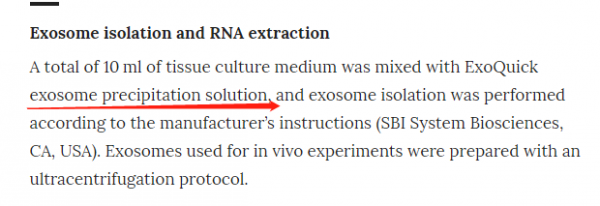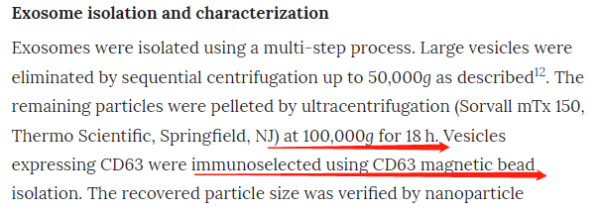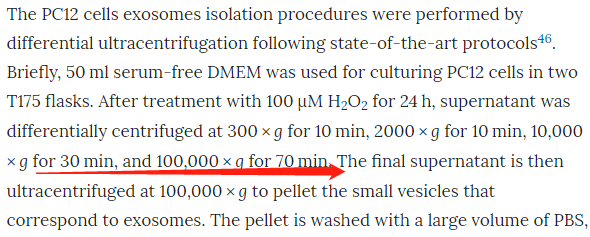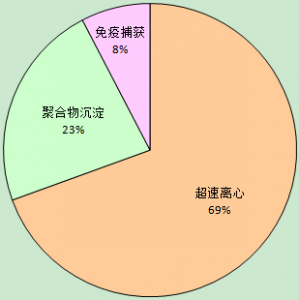外泌体(或者说小细胞外囊泡)目前的分离方法有很多种,新进入该领域的朋友很多时候都会被种类繁多的分离方法搞的无所适从。通常我们都喜欢去参考其他的文献,看看其他文献都在使用什么方法。
大家尤其喜欢参考cell science nature这三大刊物的方法。因此,我们过去曾经深挖过这些期刊使用那些方法进行外泌体的分离。大家可以阅读往期推文来了解:【套路】耀眼的文章都用什么方法分离外泌体!https://mp.weixinbridge.com/mp/wapredirect?url=http%3A%2F%2Fwww.exosomemed.com%2F4291.html
但是呢,这些耀眼的文章我们通常也就是做做参考,读一读,膜拜一下。对于我们大部分人来说,博士期间的追求可能就是五六分的文章,分数不高但是够用,拿得出手,可以参加参加会议,讲一讲墙报,甚至有时候可以等上台做一个speaker。毕竟CNS的文章过于耀眼,不亲民。CNS文章中的分离方法对于我们,尤其是对于我们的新手朋友未必那么友好[手动滑稽]。
有需求,那就要有供应。因此,今天hzangs特意翻了翻2019年发表的一些文章,看看他们都用什么方法分离外泌体。给大家一个初步的概念。这次的小调查主要选取了cancer letters、oncogene和cell death & disease这3个杂志。之所以选它们,主要是因为三个杂志分数基本都在五六分,而且发文量比较大,国人投稿也比较多。Hzangs以(杂志名+exosome[title])的方式进行了检索。可能不全,但是管中窥豹,可见一斑。略作总结调查,以给予大家一个初步的概念。
Cancer letters 检索到4篇。其中3篇使用超速离心,1篇使用聚合物沉淀。
Cancer Lett(IF:6.508):
- Malignant ascites-derived exosomes promote peritoneal tumor cell dissemination and reveal a distinct miRNA signature in advanced gastric cancer


超速离心
- Milk exosomes - Natural nanoparticles for siRNA delivery.
超速离心
- Exosomes and cells from lung cancer pleural exudates transform LTC4 to LTD4, promoting cell migration and survival via CysLT1
超速离心
- Exosomes derived from human umbilical cord mesenchymal stromal cells deliver exogenous miR-145-5p to inhibit pancreatic ductal adenocarcinoma progression
聚合物沉淀
oncogene 检索到3篇。其中2篇使用超速离心,1篇使用聚合物沉淀。
oncogene(IF:6.634):
- Hypoxic glioma-derived exosomes deliver microRNA-1246 to induce M2 macrophage polarization by targeting TERF2IP via the STAT3 and NF-κB pathways.
超速离心
(备注:oncogene这篇文章方法学引用了JCI的一篇文章,截图源自JCI文章的methods)
- Hypoxia-induced tumor exosomes promote M2-like macrophage polarization of infiltrating myeloid cells and microRNA-mediated metabolic shift.
超速离心
- Microenvironmental oxygen pressure orchestrates an anti- and pro-tumoral γδ T cell equilibrium via tumor-derived exosomes.
聚合物沉淀
Cell death & disease 检索到4篇。(两篇文章中同时使用了不同方法)其中4篇使用超速离心(1篇使用超离去除FBS外泌体),1篇使用聚合物沉淀,1篇使用免疫捕获。
Cell Death Dis(5.959):
- Exosomes from differentially activated macrophages influence dormancy or resurgence of breast cancer cells within bone marrow stroma.
超速离心、免疫捕获
- Hypoxia preconditioning promotes bone marrow mesenchymal stem cells survival by inducing HIF-1α in injured neuronal cells derived exosomes culture system
超速离心
- Exosomes derived from M1 macrophages aggravate neointimal hyperplasia following carotid artery injuries in mice through miR-222/CDKN1B/CDKN1C pathway.
超速离心
- Exosomes from CD99-deprived Ewing sarcoma cells reverse tumor malignancy by inhibiting cell migration and promoting neural differentiation.
超速离心、聚合物沉淀
汇总如下图。
可以看到,超速离心方法占到了约70%。2019年来看,在五六分的文章中,超速离心可能是目前使用最广泛的分离方法。当然,调查样本较小,可能存在偏差。但也算是管中窥豹,给大家一点概念吧。分离方法各有利弊,另外主要看实验平台的条件,以及自己实验的需求。
今天就扯到这了吧~
O(* ̄— ̄*)o 让我们沐浴春风,收获paper~ 大家加油~
外泌体资讯网 【套路】目前五六分的文章使用什么方法分离外泌体














